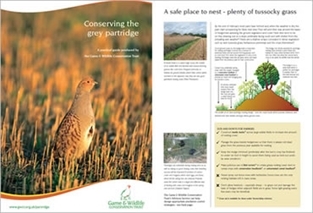 The grey partridge was in the first group of species to be given priority under the government’s 1995 Biodiversity Action Plan (BAP). The plan aimed to stabilise grey partridge numbers by 2005 and ensure that the breeding population was above 90,000 pairs by 2010. Sadly, despite changes in agricultural subsidies and improved agri-environment schemes, it is now clear that nationally, the species continues to decline. Nevertheless, there are many local successes and numbers of grey partridge pairs on sites belonging to the GWCT Partridge Count Scheme have increased by 81% between 2000 and 2010.
The grey partridge was in the first group of species to be given priority under the government’s 1995 Biodiversity Action Plan (BAP). The plan aimed to stabilise grey partridge numbers by 2005 and ensure that the breeding population was above 90,000 pairs by 2010. Sadly, despite changes in agricultural subsidies and improved agri-environment schemes, it is now clear that nationally, the species continues to decline. Nevertheless, there are many local successes and numbers of grey partridge pairs on sites belonging to the GWCT Partridge Count Scheme have increased by 81% between 2000 and 2010.
Our analysis suggests that if partridges were distributed at even modest densities across the existing farmland, there is adequate land available for over 200,000 pairs if all necessary habitats were present.
 Partridge habitat in Britain. The yellow is optimum habitat for grey partridges with a high
Partridge habitat in Britain. The yellow is optimum habitat for grey partridges with a high
proportion of arable farmland. Green is less optimal ground where livestock rearing
outweighs arable farming in importance. Grey areas are unsuited to grey partridges
for a variety of reasons. (From CEH Land Cover and OS Geographic Reference maps)
Within the Partridge Count Scheme, regular meetings of the 15 regional grey partridge groups help to explain face-to-face how to manage land effectively for grey partridges. Factsheets on habitat creation, management and predation control are also available for download from our advisory pages. Measures taken to improve grey partridges will improve the numbers of other species of farmland bird.
Join the Partridge Count Scheme
As part of its role in UK grey partridge conservation, the GWCT runs the Partridge Count Scheme as a means of offering management advice and feedback to farmers, landowners, and shoot managers on the basis of their spring and autumn counts. These counts are essential to monitor recovery and judge the success of habitat improvement.
For further information and to join this free scheme, please click here or contact the Partridge Count Co-ordinator on 01425 652381.
Get your FREE Grey Partridge Conservation Guide
An essential guide to conserving the grey partridge produced by the Game & Wildlife Conservation Trust.
What's inside your FREE guide
✓ The decline of a common farmland bird
✓ A safe place to nest - plenty of tussocky grass
✓ Chick survival - insect food is crucial
✓ Surviving winter and spring - food and cover
✓ Conservation targets - Partridge Count Scheme
✓ Grey partridges and shooting
✓ Common questions
Download guide now >